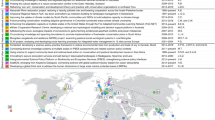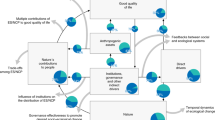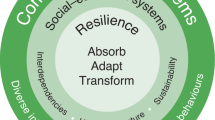Abstract
To reach the Sustainable Development Goals, we may need to act on synergies between some targets while mediating trade-offs between other targets. But what, exactly, are synergies and trade-offs, and how are they related to other outcomes, such as ‘win–win’ solutions? Finding limited guidance in the existing literature, we developed an operational method for distinguishing win–wins from eight other possible dual outcomes (lose–lose, lose–neutral and so on). Using examples related to human health and conservation, we illustrate how interdisciplinary problem-solvers can use this framework to assess relationships among targets and compare multi-target interventions that affect people and nature.
This is a preview of subscription content, access via your institution
Access options
Access Nature and 54 other Nature Portfolio journals
Get Nature+, our best-value online-access subscription
$29.99 / 30 days
cancel any time
Subscribe to this journal
Receive 12 digital issues and online access to articles
$119.00 per year
only $9.92 per issue
Buy this article
- Purchase on Springer Link
- Instant access to full article PDF
Prices may be subject to local taxes which are calculated during checkout





Similar content being viewed by others
References
A Guide to SDG Interactions: from Science to Implementation (International Council for Science, 2017); https://go.nature.com/3o5nOD3
IPBES Summary for Policymakers of the Global Assessment Report on Biodiversity and Ecosystem Services of the Intergovernmental Science-Policy Platform on Biodiversity and Ecosystem Services (IPBES Secretariat, 2019).
Schneider, F. et al. How can science support the 2030 Agenda for Sustainable Development? Four tasks to tackle the normative dimension of sustainability. Sustain. Sci. 14, 1593–1604 (2019).
Barbier, E. B. & Burgess, J. C. Sustainable development goal indicators: analyzing trade-offs and complementarities. World Dev. 122, 295–305 (2019).
Pradhan, P., Costa, L., Rybski, D., Lucht, W. & Kropp, J. P. A systematic study of Sustainable Development Goal (SDG) interactions. Earth’s Future 5, 1169–1179 (2017).
Howe, C., Suich, H., Vira, B. & Mace, G. M. Creating win-wins from trade-offs? Ecosystem services for human well-being: a meta-analysis of ecosystem service trade-offs and synergies in the real world. Glob. Environ. Change 28, 263–275 (2014).
Whitmee, S. et al. Safeguarding human health in the Anthropocene epoch: report of The Rockefeller Foundation–Lancet Commission on planetary health. Lancet 386, 1973–2028 (2015).
Naidoo, R. & Fisher, B. Reset Sustainable Development Goals for a pandemic world. Nature 583, 198–201 (2020).
Nilsson, M. et al. Mapping interactions between the sustainable development goals: lessons learned and ways forward. Sustain. Sci. 13, 1489–1503 (2018).
Cohen-Shacham, E., Walters, G., Janzen, C. & Maginnis, S. (eds) Nature-based Solutions to Address Global Societal Challenges (IUCN, 2016).
Allen, C., Metternicht, G. & Wiedmann, T. Prioritising SDG targets: assessing baselines, gaps and interlinkages. Sustain. Sci. 14, 421–438 (2019).
Mayrhofer, J. P. & Gupta, J. The science and politics of co-benefits in climate policy. Environ. Sci. Policy 57, 22–30 (2016).
Le Blanc, D. Towards Integration at Last? The Sustainable Development Goals as a Network of Targets (United Nations, Department of Economic and Social Affairs, 2015).
Sokolow, S. H. et al. Nearly 400 million people are at higher risk of schistosomiasis because dams block the migration of snail-eating river prawns. Phil. Trans. R. Soc. B 372, 20160127 (2017).
Steinmann, P., Keiser, J., Bos, R., Tanner, M. & Utzinger, J. Schistosomiasis and water resources development: systematic review, meta-analysis, and estimates of people at risk. Lancet Infect. Dis. 6, 411–425 (2006).
Sokolow, S. H. et al. Global assessment of schistosomiasis control over the past century shows targeting the snail intermediate host works best. PLoS Negl. Trop. Dis. 10, e0004794 (2016).
Martin, D. A. et al. Land-use history determines ecosystem services and conservation value in tropical agroforestry. Conserv. Lett. 13, e12740 (2020).
Medlock, J. M. et al. A review of the invasive mosquitoes in Europe: ecology, public health risks, and control options. Vector Borne Zoonotic Dis. 12, 435–447 (2012).
van Riper, C., van Riper, S. G., Goff, M. L. & Laird, M. The epizootiology and ecological significance of malaria in Hawaiian land birds. Ecol. Monogr. 56, 327–344 (1986).
Franklin, B. Protection of Towns from Fire. The Pennsylvania Gazette (4 February 1735).
Bauch, S. C., Birkenbach, A. M., Pattanayak, S. K. & Sills, E. O. Public health impacts of ecosystem change in the Brazilian Amazon. Proc. Natl Acad. Sci. USA 112, 7414–7419 (2015).
Herrera, D. et al. Upstream watershed condition predicts rural children’s health across 35 developing countries. Nat. Commun. 8, 811 (2017).
McShane, T. O. et al. Hard choices: making trade-offs between biodiversity conservation and human well-being. Biol. Conserv. 144, 966–972 (2011).
Lengeler, C. Insecticide-treated bed nets and curtains for preventing malaria. Cochrane Database Syst. Rev. https://doi.org/10.1002/14651858.CD000363.pub2 (2004).
Price, J., Richardson, M. & Lengeler, C. Insecticide-treated nets for preventing malaria. Cochrane Database Syst. Rev. https://doi.org/10.1002/14651858.CD000363.pub3 (2018).
Short, R., Gurung, R., Rowcliffe, M., Hill, N. & Milner-Gulland, E. J. The use of mosquito nets in fisheries: a global perspective. PLoS ONE 13, e0191519 (2018).
Markandya, A. et al. Counting the cost of vulture decline—an appraisal of the human health and other benefits of vultures in India. Ecol. Econ. 67, 194–204 (2008).
Buechley, E. R. & Şekercioğlu, Ç. H. The avian scavenger crisis: looming extinctions, trophic cascades, and loss of critical ecosystem functions. Biol. Conserv. 198, 220–228 (2016).
Gangoso, L. et al. Reinventing mutualism between humans and wild fauna: insights from vultures as ecosystem services providers. Conserv. Lett. 6, 172–179 (2013).
Hampson, K. et al. Estimating the global burden of endemic canine rabies. PLoS Negl. Trop. Dis. 9, e0003709 (2015).
Ogada, D. L., Torchin, M. E., Kinnaird, M. F. & Ezenwa, V. O. Effects of vulture declines on facultative scavengers and potential implications for mammalian disease transmission. Conserv. Biol. 26, 453–460 (2012).
Breuer, E., Lee, L., De Silva, M. & Lund, C. Using theory of change to design and evaluate public health interventions: a systematic review. Implement. Sci. 11, 63 (2016).
Constructing Theories of Change for Ecosystem-Based Adaptation Projects: A Guidance Document (Conservation International, 2013).
de Wit, L. A. et al. Estimating burdens of neglected tropical zoonotic diseases on islands with introduced mammals. Am. J. Trop. Med. Hyg. 96, 749–757 (2017).
Morand, S. et al. Global parasite and Rattus rodent invasions: the consequences for rodent-borne diseases. Integr. Zool. 10, 409–423 (2015).
Duron, Q., Shiels, A. B. & Vidal, E. Control of invasive rats on islands and priorities for future action. Conserv. Biol. 31, 761–771 (2017).
Vanderwerf, E. A. Importance of nest predation by alien rodents and avian poxvirus in conservation of Oahu elepaio. J. Wildl. Manag. 73, 737–746 (2009).
Pender, R. J., Shiels, A. B., Bialic-Murphy, L. & Mosher, S. M. Large-scale rodent control reduces pre- and post-dispersal seed predation of the endangered Hawaiian lobeliad, Cyanea superba subsp. superba (Campanulaceae). Biol. Invasions 15, 213–223 (2013).
Hoare, J. M. & Hare, K. M. The impact of brodifacoum on non-target wildlife: gaps in knowledge. N. Z. J. Ecol. 30, 157–167 (2006).
DataBank (The World Bank, 2020); https://databank.worldbank.org/home.aspx
Progress on Drinking Water and Sanitation: 2012 Update (World Health Organization and UNICEF, 2012); https://go.nature.com/2HOJFOR
Acknowledgements
The Ecological Levers for Health working group was supported by the Science for Nature and People Partnership (SNAPP). L.H.K. and I.J.J. were supported by NSF Graduate Research Fellowships (nos. DGE-114747 and 1656518). N.N. was supported by the Bing Fellowship in Honor of Paul Ehrlich and the Stanford Data Science Scholars program. A.J.P. was supported by a Queensland Government Accelerate Postdoctoral Research Fellowship and an ARC DECRA fellowship (DE190100710). C.L.W. was supported by a grant from the National Science Foundation (OCE-1829509), an Alfred P. Sloan Foundation Sloan Research Fellowship, and a University of Washington Innovation Award. A.J.L. was supported by a James and Nancy Kelso Stanford Interdisciplinary Graduate Fellowship. A.J.M. was supported by a NSF Postdoctoral Research Fellowship in Biology (no. 1611767). G.A.D.L., A.J.P. and S.H.S. were partially supported by the National Institutes of Health (R01TW010286), the National Science Foundation (CNH1414102), and a GDP SEED grant from the Freeman Spogli Institute at Stanford University. G.A.D.L. was also partially supported by NSF DEB no. 2011179. K.D.L. was supported by the Ecosystem Mission Area of the US Geological Survey. Any use of trade, product, or firm names in this publication is for descriptive purposes only and does not imply endorsement by the US Government.
Author information
Authors and Affiliations
Contributions
S.R.H., K.D.L., S.H.S. and G.A.D.L. designed the framework with input from all authors; N.N. and S.R.H. created the figures with design input from all authors; S.R.H. led the writing, and all authors wrote and revised the drafts. All authors gave final approval for publication.
Corresponding author
Ethics declarations
Competing interests
The authors declare no competing interests.
Additional information
Peer review information Nature Sustainability thanks Christopher Golden, Melissa Marselle and Kris Murray for their contribution to the peer review of this work.
Publisher’s note Springer Nature remains neutral with regard to jurisdictional claims in published maps and institutional affiliations.
Rights and permissions
About this article
Cite this article
Hopkins, S.R., Sokolow, S.H., Buck, J.C. et al. How to identify win–win interventions that benefit human health and conservation. Nat Sustain 4, 298–304 (2021). https://doi.org/10.1038/s41893-020-00640-z
Received:
Accepted:
Published:
Issue Date:
DOI: https://doi.org/10.1038/s41893-020-00640-z
This article is cited by
-
High genetic diversity of the himalayan marmot relative to plague outbreaks in the Qinghai-Tibet Plateau, China
BMC Genomics (2024)
-
Ecological countermeasures to prevent pathogen spillover and subsequent pandemics
Nature Communications (2024)
-
Co-benefits of marine protected areas for nature and people
Nature Sustainability (2023)
-
Synergy of climate change with country success and city quality of life
Scientific Reports (2023)
-
Sustainability spillover effects of social, environment and economy: mapping global sustainable development in a systematic analysis
Asia-Pacific Journal of Regional Science (2023)



